A compound classifier combines other base classifiers into groups with AND/OR relationships. This enables the creation of complex configurations in which a file must meet all (AND) or any (OR) of the specified criteria to be flagged.
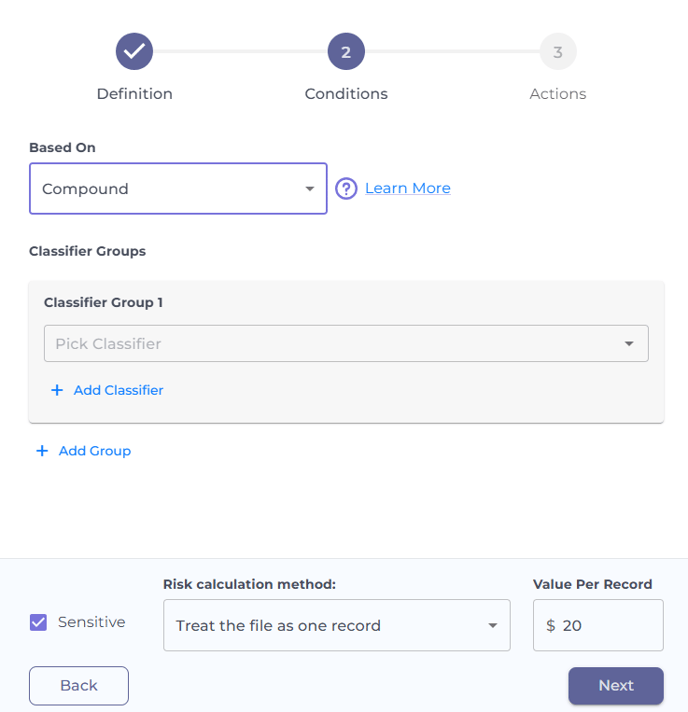
Use case
Set up a compound classifier to flag files that both contain sensitive content (like credit card numbers) and have specific file extensions (like .docx). Alternatively, a compound classifier could flag files that meet either criteria, ensuring broader coverage for different types of sensitive data.
Configurations
This section outlines the configurations available when setting up a compound classifier. For detailed instructions on creating or editing a classifier, click here.
1. Compound classifiers allow you to create groups by combining multiple existing classifiers. To add a new classifier to a group, click on Add Classifier. You can configure groups with AND/OR relations:
- AND: A file must satisfy all the conditions within the group to be flagged as sensitive.
- OR: A file will be flagged as sensitive if it satisfies any of the conditions within the group.
Example
In the screenshot, a file will be marked as sensitive if it meets the conditions for both the Australia – Passport Number and Australia – Tax File Number classifiers.

2. You can create a new group of classifiers by clicking on Add Group. Like individual classifiers, groups can also have AND/OR relations:
- AND: A file must meet the conditions of all groups to be flagged as sensitive.
- OR: A file will be flagged if it satisfies the conditions of any one group.
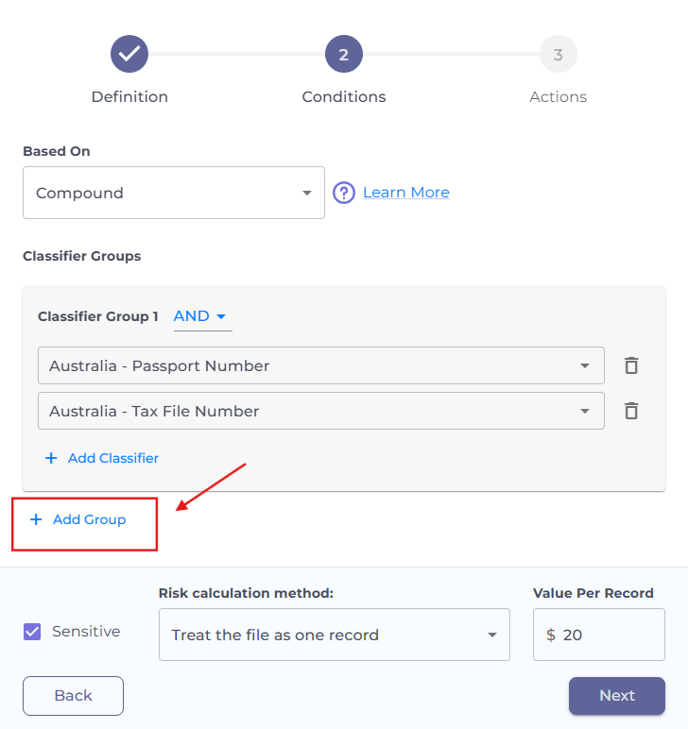
Example 1
A file is flagged as sensitive:
- Either if it satisfies the conditions of both the Australian Passport Number and Australian Tax File Number classifiers
- Or it satisfies the conditions of both the Finnish Social Security Number and Finnish VAT Number classifiers.
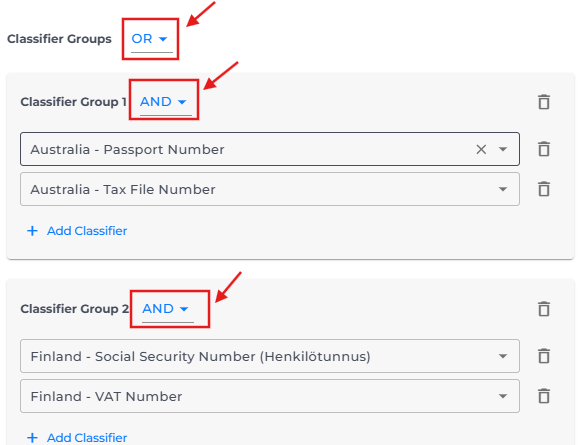
Example 2
A file is flagged as sensitive in any of the following cases:
- It satisfies the conditions of both Australian passport number and Finnish social security number classifiers;
- It satisfies the conditions of both Australian passport number and Finnish VAT number classifiers;
- It satisfies the conditions of both Australian tax file number and Finnish social security number classifiers;
- It satisfies the conditions of both Australian tax file number and Finnish VAT number classifiers.
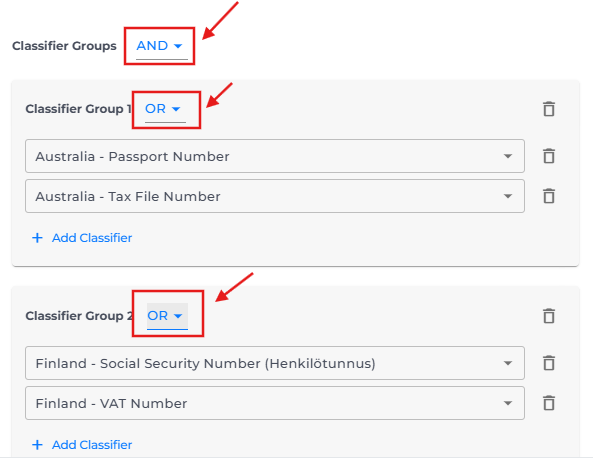
3. You can set the risk calculation method to either the entire file or one of the classifier groups.
Example 1
- Scenario: The file contains data satisfying conditions in both Classifier Group 1 (Australia – Passport Number and Australia – Tax File Number classifiers) and Classifier Group 2 (Finland – Social Security Number and Finland VAT Number classifiers).
- Duplicate count in the individual settings of the classifiers involved: checked for all.
- Sensitive data occurrences: five Australian passport numbers, one Australian tax file number, one Finnish social security number, and ten Finnish VAT numbers.
- Value per record: $20.
- Risk calculation method: Highest count in Classifier Group 1.
- Calculation: The risk calculation will be based on the classifier in Group 1 that has the highest number of records. Australia – Passport Number: five occurrences, five records (the duplicate count is enabled). Australia – Tax File Number: one occurrence, one record. The classifier of Group 1 with the most records is Australia – Passport Number (five records).
- Total risk value of the file: 5 records × $20 = $100.
Example 2
- Scenario: The file contains data satisfying conditions in both Classifier Group 1 (Australia – Passport Number and Australia – Tax File Number classifiers) and Classifier Group 2 (Finland – Social Security Number and Finland VAT Number classifiers).
- Duplicate count in the individual settings of the classifiers involved: unchecked for all.
- Sensitive data occurrences: five Australian passport numbers, one Australian tax file number, one Finnish social security number, and ten Finnish VAT numbers.
- Value per record: $20.
- Risk calculation method: Highest count in Classifier Group 1.
- Calculation: The risk calculation will be based on the classifier in Group 1 that has the highest number of records. Australia – Passport Number: five occurrences, one record (the duplicate count is unchecked). Australia – Tax File Number: one occurrence, one record. The highest number of records in Compound Group 1 is one record.
- Total risk value of the file: 1 record × $20 = $20.
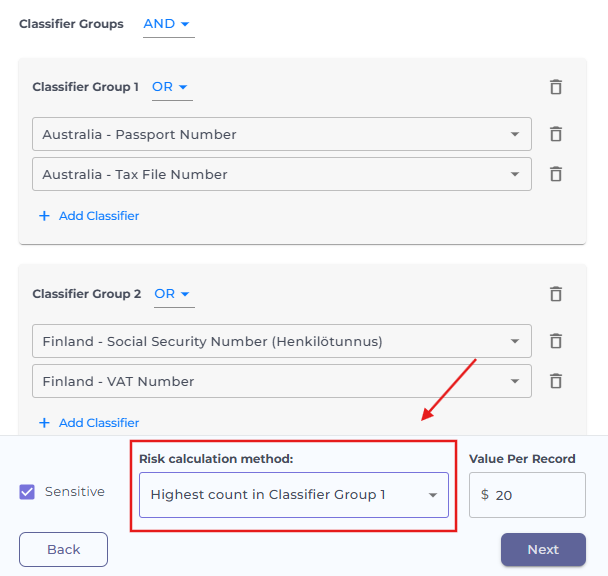
Example 3
- Scenario: The file contains data satisfying conditions in both Classifier Group 1 (Australia – Passport Number and Australia – Tax File Number classifiers) and Classifier Group 2 (Finland – Social Security Number and Finland VAT Number classifiers).
- Duplicate count in the individual settings of the classifiers involved: checked or unchecked.
- Sensitive data occurrences: five Australian passport numbers, one Australian tax file number, one Finnish social security number, and ten Finnish VAT numbers.
- Value per record: $20.
- Risk calculation method: Treat the file as one record.
- Calculation: None of the individual classifiers is taken into account. Since the file meets the conditions of the compound classifier, it will be treated as a single record.
- Total risk value of the file: 1 record × $20 = $20.
